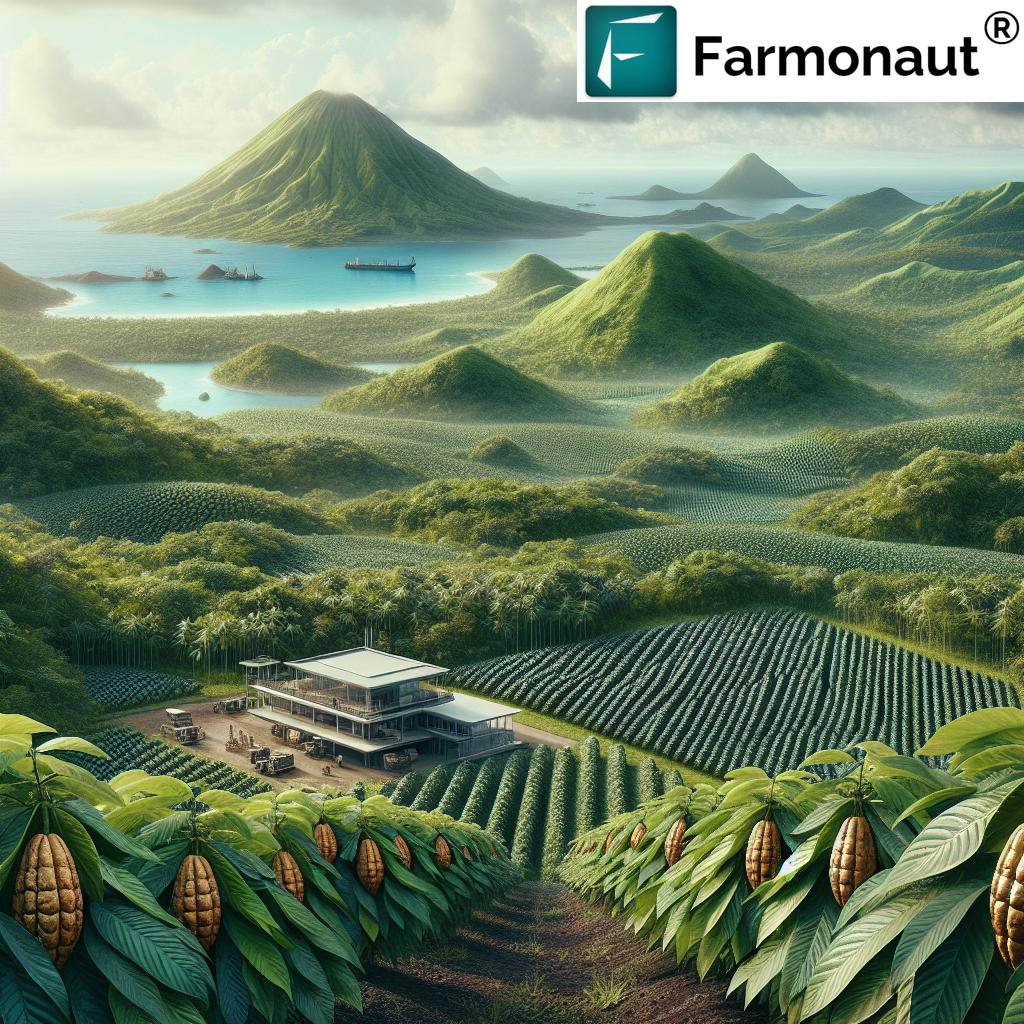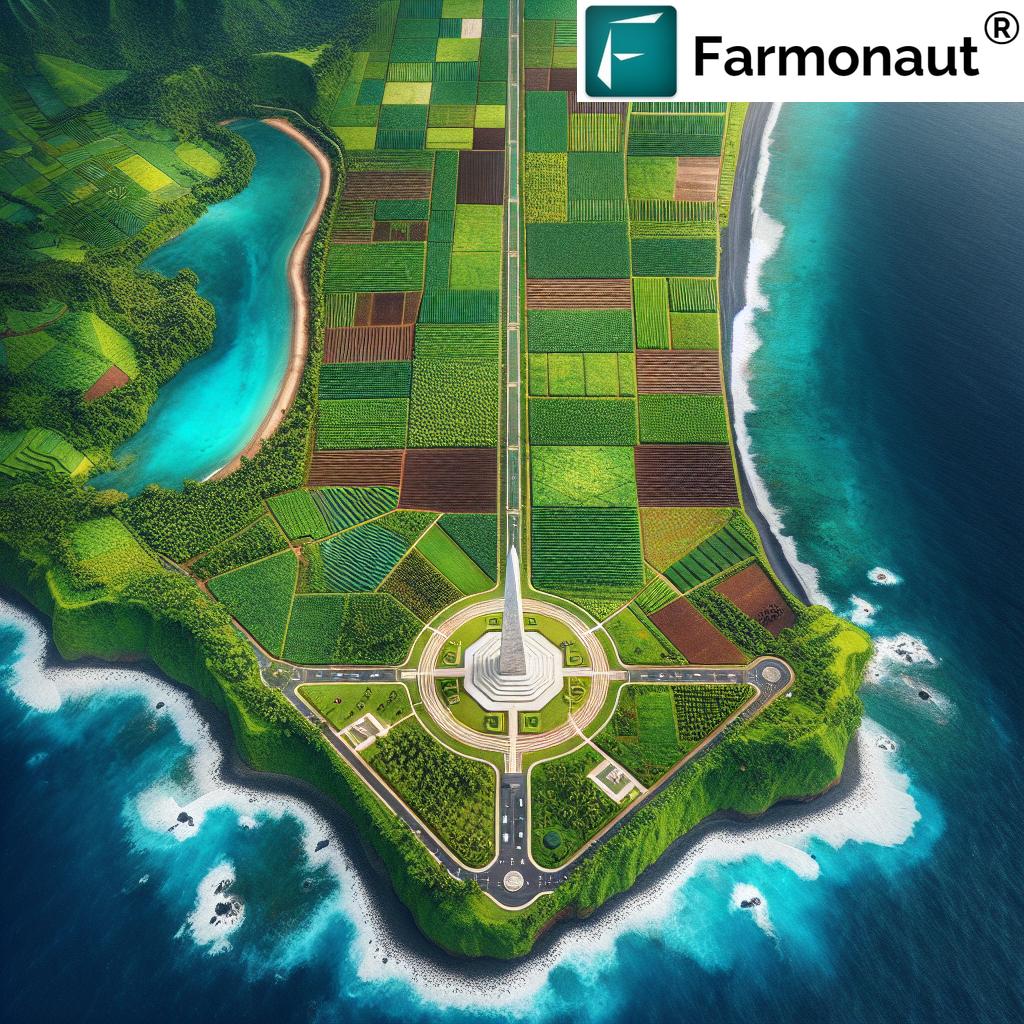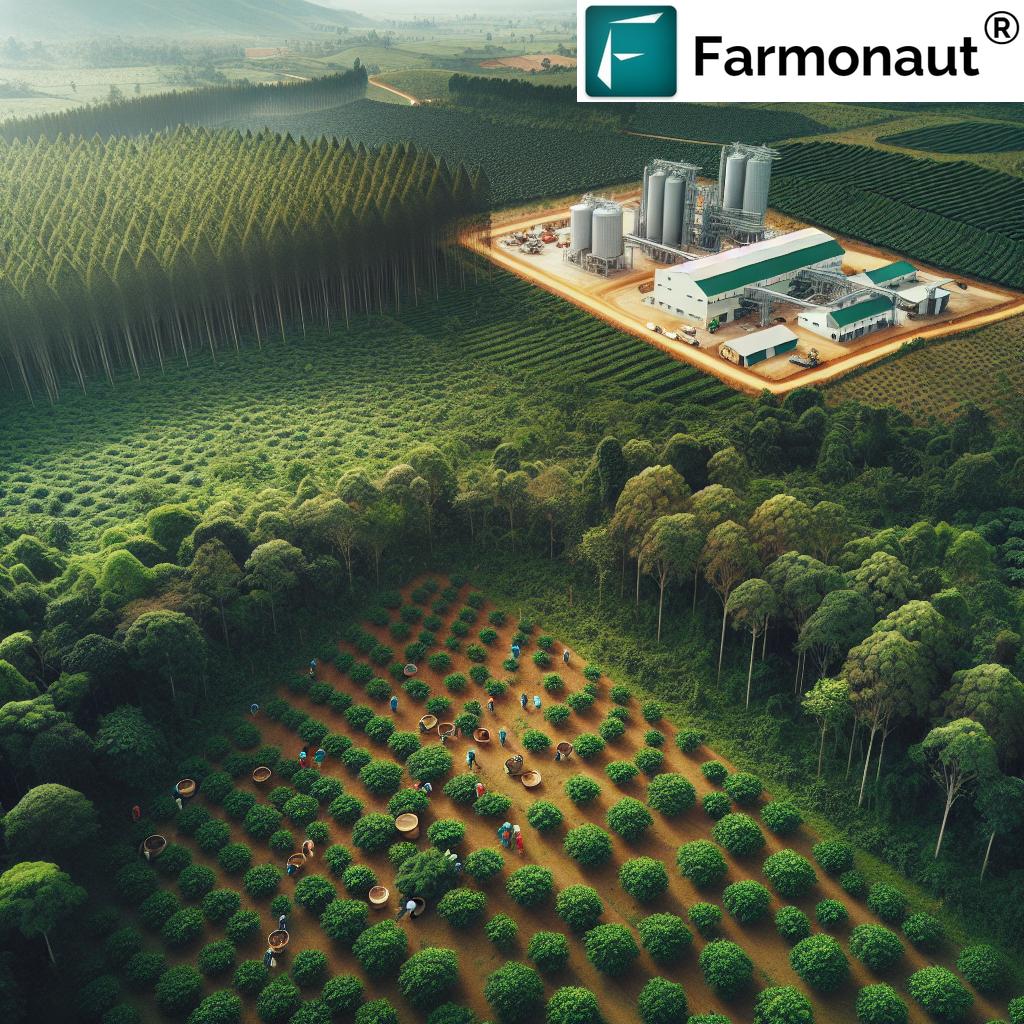Reviving Sao Tome and Principe: Sustainable Organic Cocoa and Eco-Tourism Driving Island Nation’s Economic Renaissance

“Sao Tome and Principe, located at 0°N 0°E, is the closest nation to the intersection of the Equator and Prime Meridian.”
At the heart of the Gulf of Guinea, where the Prime Meridian kisses the Equator, lies a hidden gem of Africa – Sao Tome and Principe. This small island nation, often referred to as the “Chocolate Islands,” is embarking on a remarkable journey of economic revival through sustainable organic cocoa production and eco-tourism. As we at Farmonaut delve into the fascinating story of this equatorial paradise, we’ll explore how this tiny country is leveraging its unique geographical position and rich natural resources to carve out a niche in the global market.
The Geographical Marvel: Sao Tome and Principe
Sao Tome and Principe, a two-island nation off the west coast of Africa, is truly a geographical marvel. Located precisely at the intersection of the Equator and the Prime Meridian, it’s often dubbed “the center of the world.” This unique position not only gives the country a special place on the map but also blesses it with an ideal tropical climate and volcanic soil fertility that’s perfect for agriculture, especially cocoa cultivation.
- Location: Gulf of Guinea, West Africa
- Coordinates: 0°N 0°E
- Total Area: 1,001 km² (386 sq mi)
- Climate: Tropical, hot and humid
The islands’ volcanic origin has endowed them with incredibly fertile soil, making them a potential agricultural powerhouse. This natural advantage is now being harnessed as the country turns towards sustainable organic cocoa production as a key driver of its economic renaissance.
The Legacy of Cocoa: From Colonial Cash Crop to Sustainable Future
Cocoa has been the lifeblood of Sao Tome and Principe’s economy since its introduction by Portuguese colonizers in the 15th century. For a significant period, this tiny nation was the world’s largest cocoa producer. However, the industry’s history is marred by the dark legacy of slavery and exploitation.
Post-independence in 1975, the cocoa industry faced numerous challenges:
- Decline in global cocoa prices
- Outdated farming techniques
- Competition from larger West African producers
- Lack of investment in infrastructure
Despite these setbacks, cocoa remains central to the country’s economy and identity. Today, we’re witnessing a remarkable revival of the industry, with a focus on organic, high-quality cocoa production.
The Organic Cocoa Renaissance
“Organic cocoa production in Sao Tome and Principe has increased by over 50% since 2014, driving economic growth.”
The shift towards organic cocoa production is more than just a trend; it’s a strategic move that aligns with global consumer preferences and sustainable agricultural practices. This renaissance is characterized by several key factors:
- Quality over Quantity: Focus on producing high-grade, flavor-rich cocoa beans
- Sustainable Farming Practices: Adoption of organic farming techniques that preserve soil health and biodiversity
- Fair Trade Partnerships: Collaboration with international chocolate makers to ensure fair prices for farmers
- Local Value Addition: Development of local chocolate brands to capture more value from the cocoa supply chain
This shift towards organic production is not just beneficial for the environment but also for the farmers. Organic cocoa commands premium prices in the international market, providing better income opportunities for local communities.
Equatorial Farming Techniques: Adapting to Tropical Climates
The success of Sao Tome and Principe’s organic cocoa revival is largely due to the adaptation of equatorial farming techniques suited to its unique tropical climate. These techniques include:
- Agroforestry: Integrating cocoa trees with other forest species to create a balanced ecosystem
- Shade Management: Utilizing taller trees to provide optimal shade for cocoa plants
- Natural Pest Control: Employing biological methods to manage pests without chemical pesticides
- Water Conservation: Implementing innovative irrigation systems to manage water resources efficiently
These practices not only ensure the production of high-quality organic cocoa but also contribute to the preservation of the islands’ rich biodiversity. As a result, Sao Tome and Principe is becoming a model for sustainable agriculture in tropical climates.
Eco-Tourism: The Second Pillar of Economic Renaissance
While cocoa remains the backbone of Sao Tome and Principe’s economy, eco-tourism is emerging as a powerful complementary force in the country’s economic revival. The islands’ pristine beaches, lush rainforests, and unique biodiversity offer a paradise for nature lovers and adventure seekers.
Key attractions include:
- Obo National Park: Home to diverse flora and fauna, including endemic species
- Ilheu das Rolas: An islet that marks the exact location where the Equator crosses the Prime Meridian
- Pristine Beaches: Untouched coastlines perfect for relaxation and water sports
- Historical Plantations: Former cocoa estates converted into eco-lodges
The development of eco-tourism not only provides economic opportunities but also reinforces the country’s commitment to environmental conservation. It creates a symbiotic relationship between tourism and agriculture, where visitors can experience the organic cocoa production process firsthand.
Explore Farmonaut’s API for advanced agricultural insights
Challenges and Opportunities in Island Nation Tourism Development
While Sao Tome and Principe’s potential for eco-tourism is immense, the country faces several challenges in developing this sector:
- Limited Infrastructure: Inadequate transportation and healthcare facilities
- Accessibility: Limited international flight connections
- Awareness: Low global recognition as a tourist destination
- Capacity Building: Need for trained personnel in the hospitality industry
Despite these challenges, the opportunities are significant. The government is actively working on:
- Improving air connectivity with major African and European cities
- Investing in sustainable tourism infrastructure
- Promoting the islands as a unique, off-the-beaten-path destination
- Developing agri-tourism experiences centered around organic cocoa production

Balancing Economic Growth with Biodiversity Conservation
One of the most critical aspects of Sao Tome and Principe’s development strategy is maintaining a delicate balance between economic growth and biodiversity conservation. The islands are home to numerous endemic species, making them a biodiversity hotspot of global importance.
Strategies for sustainable development include:
- Protected Area Management: Expanding and effectively managing national parks and reserves
- Sustainable Agriculture: Promoting organic farming practices that preserve soil health and biodiversity
- Community Involvement: Engaging local communities in conservation efforts
- Green Energy Initiatives: Investing in renewable energy sources to reduce reliance on fossil fuels
By prioritizing biodiversity conservation alongside economic development, Sao Tome and Principe is setting an example for sustainable growth in small island nations.
Check out Farmonaut’s API Developer Docs for integration possibilities
Agricultural Partnerships in Africa: Lessons from Sao Tome and Principe
Sao Tome and Principe’s journey in reviving its cocoa industry and developing sustainable agriculture offers valuable lessons for other African nations. Key takeaways include:
- Focus on Niche Markets: Specializing in high-quality, organic products can provide a competitive edge
- Sustainable Practices: Adopting environmentally friendly farming methods ensures long-term viability
- Value Addition: Developing local processing capabilities to capture more value from agricultural products
- Diversification: Combining agriculture with complementary sectors like eco-tourism for economic resilience
These strategies can be adapted and applied to other African countries facing similar agricultural challenges, promoting sustainable development across the continent.
The Role of Technology in Sustainable Agriculture
As Sao Tome and Principe embraces sustainable agriculture, technology plays a crucial role in enhancing productivity and efficiency. Advanced agricultural technologies, such as those offered by Farmonaut, can significantly contribute to the country’s agricultural renaissance.
Key technological interventions include:
- Satellite-Based Crop Monitoring: Providing real-time insights into crop health and growth patterns
- Precision Agriculture: Optimizing resource use through data-driven decision-making
- Weather Forecasting: Improving crop planning and risk management
- Soil Analysis: Enhancing soil health management for sustainable cocoa production
By leveraging these technologies, Sao Tome and Principe can further boost its organic cocoa production while maintaining sustainable practices.
The Future of Sao Tome and Principe: A Model for Sustainable Island Economies
As we look to the future, Sao Tome and Principe stands poised to become a model for sustainable development in small island nations. By focusing on organic cocoa production and eco-tourism, the country is creating a unique economic identity that prioritizes both growth and conservation.
Key areas of future development include:
- Expanding Organic Certification: Increasing the area under certified organic cocoa production
- Developing Agri-Tourism: Creating immersive experiences around cocoa cultivation and processing
- Enhancing Digital Infrastructure: Improving connectivity to support both agriculture and tourism sectors
- Investing in Renewable Energy: Reducing dependence on fossil fuels and promoting clean energy solutions
As Sao Tome and Principe continues on this path, it not only secures its own future but also provides valuable lessons for other nations grappling with the challenges of sustainable development in the face of climate change and economic pressures.
Sao Tome and Principe’s Sustainable Development Indicators
| Indicator | 2010 (Estimated) | 2020 (Estimated) | 2030 Target |
|---|---|---|---|
| Organic Cocoa Production (tons/year) | 500 | 1,200 | 2,500 |
| Eco-Tourism Visitors | 8,000 | 17,000 | 50,000 |
| Forest Cover (%) | 85% | 82% | 85% |
| Renewable Energy Use (%) | 5% | 15% | 50% |
| Sustainable Agriculture Land (hectares) | 5,000 | 10,000 | 20,000 |
Conclusion: A Sweet Future for the Chocolate Islands
Sao Tome and Principe’s journey from a colonial cocoa powerhouse to a modern, sustainable organic cocoa producer and eco-tourism destination is a testament to the power of vision, innovation, and commitment to sustainability. By leveraging its unique geographical position, rich biodiversity, and the legacy of cocoa cultivation, this small island nation is carving out a niche for itself in the global market.
The revival of organic cocoa production, coupled with the development of eco-tourism, presents a sustainable path forward for Sao Tome and Principe. This dual approach not only promises economic growth but also ensures the preservation of the islands’ natural beauty and biodiversity for future generations.
As the world increasingly values sustainable and ethically produced goods, Sao Tome and Principe’s organic cocoa and pristine natural landscapes position it well for future success. The country’s commitment to balancing economic development with environmental conservation sets an inspiring example for other small island nations and developing countries worldwide.
In the coming years, as Sao Tome and Principe continues to refine its strategies and overcome challenges, it may well become a shining example of how a small nation can leverage its natural resources and unique attributes to create a sustainable, prosperous future. The sweet aroma of success is in the air for these Chocolate Islands, promising a future as rich and satisfying as the finest organic cocoa they produce.
FAQs about Sao Tome and Principe’s Economic Renaissance
- Q: What makes Sao Tome and Principe’s cocoa unique?
A: Sao Tome and Principe’s cocoa is known for its high quality and unique flavor profile, attributed to the islands’ volcanic soil and ideal climate. The focus on organic production further enhances its appeal in the global market. - Q: How is eco-tourism contributing to the country’s economy?
A: Eco-tourism is providing a complementary source of income, creating jobs, and attracting foreign investment. It also helps in preserving the islands’ natural beauty and biodiversity. - Q: What challenges does Sao Tome and Principe face in its development efforts?
A: Key challenges include limited infrastructure, accessibility issues, and the need for skilled labor in both agriculture and tourism sectors. - Q: How is technology being used in Sao Tome and Principe’s agricultural sector?
A: Technologies like satellite-based crop monitoring, precision agriculture techniques, and advanced weather forecasting are being employed to enhance agricultural productivity and sustainability. - Q: What lessons can other countries learn from Sao Tome and Principe’s development strategy?
A: The key takeaways include focusing on niche markets, adopting sustainable practices, adding value to raw products, and diversifying the economy through complementary sectors like tourism.
















